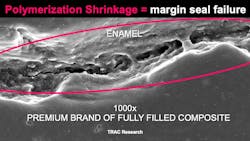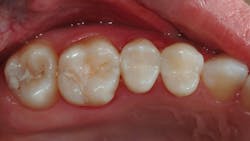Are flowable composites adequate restorations?
Flowable composite resins appear to have improved significantly since their introduction many years ago. They are very popular, and some composite companies promote them as though they are an equal replacement for fully filled putty restorative resins. Yet, I have seen wear on flowable composites placed in areas where they are in occlusal contact, and I have had patients experience postoperative tooth sensitivity occasionally as can occur with fully filled resins. Please provide your candid opinion about the use of flowable resins as a substitute for “normal” restorative resins.
Their higher shrinkage makes flowable resin restorations even more prone to these problems. Any current composite, irrespective of filler content, has the same challenges to varying degrees, inviting the well-known recurrence of caries in just a few years.
Characteristics of flowable composite resins compared to conventional resins:
- Typical flowables shrink about 3%, while conventional resins shrink 2% or less.2 This is a great improvement over the original flowable resins, but it is still a negative. Polymerization shrinkage of all current dental resins is a negative characteristic that resin companies have been trying to reduce or eliminate for at least 70 years. It remains yet to be overcome.
- The filler content in almost all flowables is less than that of conventional resins, which is responsible for higher wear.
- Flowables are more flexible when subjected to load than conventional resins, which is good in some situations but can contribute to challenges in others.
- Without exception, flowables are weaker than conventional resins.
Are there valid uses for flowables? The answer to that question is easy. Only a few uses can be supported from clinical and research standpoints. The flowable characteristics listed above are not impressive compared to fully filled resins, but sales of flowables continue to be high. Why is this the case? Dentists are attracted to the main positive characteristic of flowables—they flow! But so what?
The following information shares the research and clinical observations of experienced clinicians related to the situations in which flowables are desirable. Some of these refute a few of the reported advertised and popular uses.
Judging from survey data conducted by Clinicians Report Foundation (CR), repair of provisional restorations is the most common use of flowables. Clinicians often have voids in bis-acryl provisional restorations when they are removed from their vinyl matrix impressions. This problem occurs particularly when several prepped teeth are connected or when making fixed prostheses with pontics. These voids are unsightly if located in esthetic areas and are often found in marginal areas causing leakage and sensitivity.
Read more by Gordon Christensen:
Is an implant better than a tooth?
Why are sealants failing?
Making another mix of bis-acryl for such needed repairs is a time-consuming and relatively expensive alternative, and some brands of bis-acryl will not bond to previously set bis-acryl. Therefore, that fix is usually not acceptable.
Many brands of relatively translucent flowable material are incapable of matching the relatively opaque colors of the bis-acryl provisional materials. This causes an objectionable color mismatch of the obvious repair.
I suggest that clinicians—whether staff or dentist—experiment with various brands and colors of flowable to determine which of them matches their most used bis-acryl or other provisional material. Some flowables match relatively well while others are not acceptable.
Some clinicians attempt to reline unacceptable bis-acryl provisional restorations with flowable resin. This is illogical, since flowables have the same or more negative characteristics when compared to fully filled restorative resins. Tooth sensitivity can be expected when using this procedure. Remaking the provisional is the most acceptable alternative, and that usually requires only a few minutes.
Since indirect restorations remain a major procedure for most general dentists and two-appointment conventional impressions for crowns comprise about 80% of crown procedures,3 repair of provisional restorations will remain the most common use of flowables.
Repair of composite margins
Although reported in surveys to be a use for flowables, this technique is only a patch of an already failing, relatively inadequate, fully filled composite material. However, repair of broken-down composite margins with flowable resin can provide at least a temporary solution of such challenges.
Sealants
Sealants have been around since the late 1950s, and some of the inferior brands are still sold and in use today. How were the older sealant materials inferior? They had very low filler content, which caused excessive wear. Their shrinkage was two to three times more than fully filled resins. The result of these characteristics, in addition to lack of meticulous removal of plaque from surfaces to be sealed, has caused international research data to show 50% of sealants coming off within five years of placement.4 Even recent research projects are showing similar depressing data. The explanation is this: plaque is usually not cleaned out of the grooves to be sealed, the acid cannot etch through the plaque, the high wear of the sealant material allows the eventual exposure of the retained plaque, the sealant comes off, and caries continues!
CR has long promoted a successful sealant procedure, the essence of which is using an air polisher to remove the plaque and the current generation of flowables of fully filled resins as the sealant.
Here is the successful version of the sealant procedure:
- Clean grooves with an air slurry polisher or a small bur (most popular is Cavitron Prophy Jet).
- Neutralize the remaining basic sodium bicarbonate residue with a three-second application of the same acid you will use later for the actual etch of the enamel.
- If the grooves are still stained, there is a high probability the tooth has active caries in it. Cut a prep and restore the tooth. If there is no stain, go to step 4.
- Etch the groove/prep for the normal 15 seconds, or about 20 seconds if in a fluoridated geographic location. Wash and dry.
- Carefully place a glutaraldehyde solution on the groove area to be sealed, avoiding the soft tissue (popular products include Zest MicroPrime, Kulzer Gluma). Do not wash the solution off. Instead, suction it off to avoid damage to the soft tissues.
- Place any bonding agent on the area and air-thin it. Don’t cure; you want a thin layer only to “wet” the surface and allow the restorative resin to go into the acid-etched irregularities.
- Place the flowable resin of your choice. One of the most popular is Filtek Supreme Ultra Flow.
- Check the occlusion.
Liners
This is a controversial potential use of flowables, but it is promoted by some clinicians. Although a layer of flowable resin “wets” the surfaces to which it is applied, allowing the resin to flow more easily into the acid-etched irregularities, so does a thin layer of bonding agent. Remember the negatives of flowables that have already been discussed. There are some dentists, however, who claim to have success with this technique.
If using a flowable as a liner, an important decision must be made—whether to cure the flowable layer before placing the fully filled resin or just blow it thin. Both options are promoted, and both appear to have some negative and some potentially positive characteristics. This use is not my personal preference. Using any of the conventional resin bonding materials is adequate.
Small restorations not in occlusion
This potential use for flowables has the advantage of easy application into a small prep, but the known negative characteristics of flowables make this technique less acceptable than using fully filled resins.
Replacement for fully filled restorative resins
Summary
CR surveys tell us that more than 86% of dentists use flowable resins, but only for the specific situations described in this article. The use of flowables has been shown to be decreasing.4 Some viable uses for flowable resins have been supported, but the use of flowables as a replacement for fully filled resin-based composites is discouraged (figure 3).
Author’s note: The following educational materials from Practical Clinical Courses offer further resources on this topic for you and your staff.
One-hour videos:
- Making Dental Caries Prevention a “Win-Win” Concept (Item no. V5120)
- Mastering Frequent Esthetic Challenges with Resin (Item no. V3582)
Two-day hands-on courses in Utah:
- Restorative Dentistry 1—Restorative/Esthetic/Preventive with Dr. Gordon Christensen
- Faster, Easier, Higher Quality Dentistry with Dr. Gordon Christensen
For more information, visit pccdental.com or contact Practical Clinical Courses at (800) 223-6569.
Editor's note: This article appeared in the November 2021 print edition of Dental Economics.
References
- Are your class II resin-based composites serving well? Clinicians Report. 2016;9(3):2. https://www.cliniciansreport.org/products/dental-reports/are-your-class-ii-resin-based-composites-serving-well-dry-mouth-is-amalgam-a-systemic-or-environmental-hazard-march-2016-volume-9-issue-3
- Flowables: essential product or just niche material? Clinicians Report. 2021;14(7):3. https://www.cliniciansreport.org/products/single-topic-articles/single-topic-2-from-july-2021-volume-14-issue-7
- Withrow D. Data from Glidewell Laboratory.
- Sealants 2016: Extend longevity with proven products and technique. Clinicians Report. 2016;9(4). https://www.cliniciansreport.org/products/dental-reports/cutting-soft-tissue-which-method-is-best-death-tragedy-in-the-dental-office-prevention-sealants-2016-extend-longevity-with-proven-products-and-technique-april-2016-volume-9-issue-4.php
About the Author

Gordon J. Christensen, DDS, PhD, MSD
Gordon J. Christensen, DDS, PhD, MSD, is founder and CEO of Practical Clinical Courses and cofounder of Clinicians Report. His wife, Rella Christensen, PhD, is the cofounder. PCC is an international dental continuing education organization founded in 1981. Dr. Christensen is a practicing prosthodontist in Provo, Utah.



